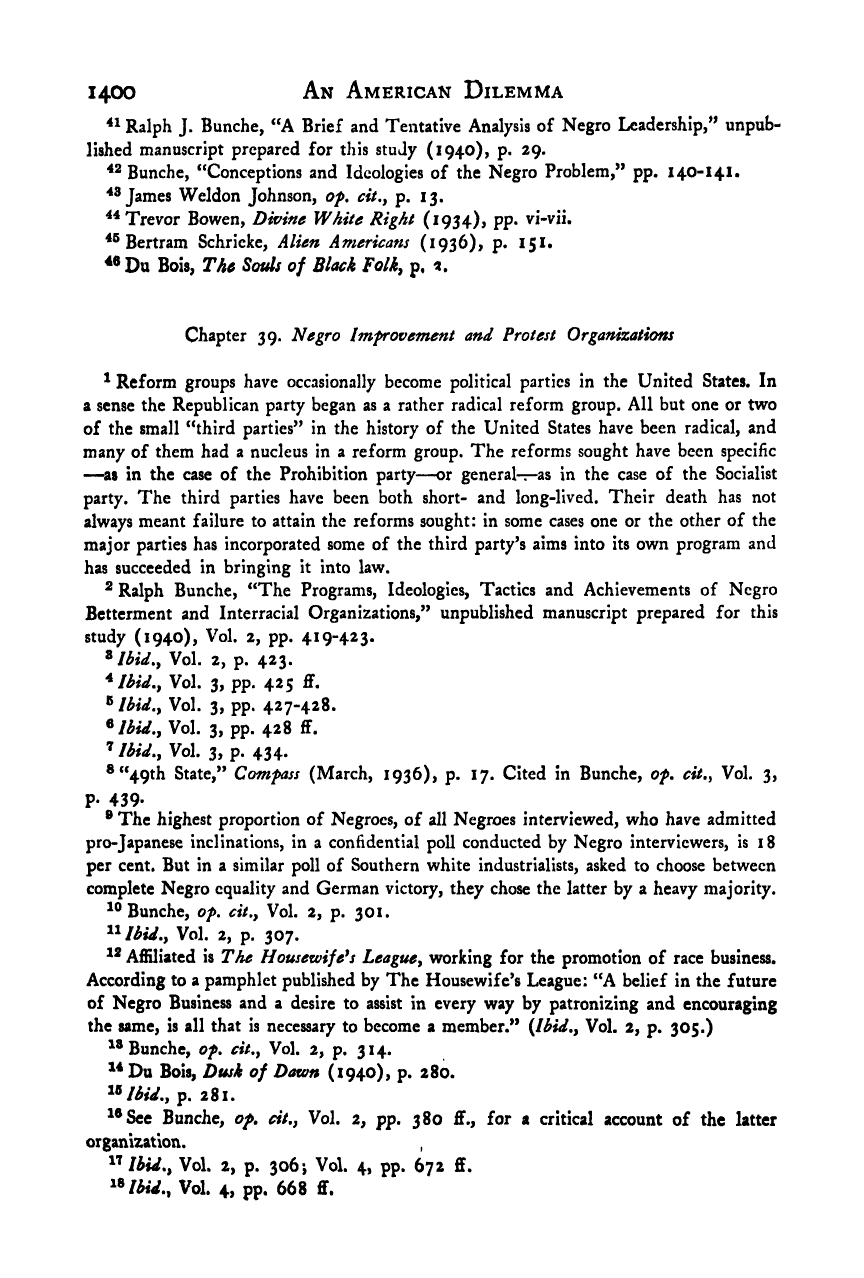Note: Gunnar Myrdal died in 1987, less than 70 years ago. Therefore, this work is protected by copyright, restricting your legal rights to reproduce it. However, you are welcome to view it on screen, as you do now. Read more about copyright.
Full resolution (TIFF) - On this page / på denna sida - Footnotes - Chapter 38 - Chapter 39

<< prev. page << föreg. sida << >> nästa sida >> next page >>
Below is the raw OCR text
from the above scanned image.
Do you see an error? Proofread the page now!
Här nedan syns maskintolkade texten från faksimilbilden ovan.
Ser du något fel? Korrekturläs sidan nu!
This page has never been proofread. / Denna sida har aldrig korrekturlästs.
1400 An American Dilemma
Ralph J. Bunche, “A Brief and Tentative Analysis of Negro Leadership,” unpub-
lished manuscript prepared for this study (1940), p. 29.
Bunche, “Conceptions and Ideologies of the Negro Problem,” pp. 140-141.
James Weldon Johnson, of. cit.y p. 13.
Trevor Bowen, Divine White Right (1934), pp. vi-vii.
Bertram Schrieke, Alien Americans (1936), p. 151.
Du Bois, The Souls of Black Folk^ p, 2.
Chapter 39. Negro Imfrovement and Protest Organizations
^
Reform groups have occasionally become political parties in the United States. In
a sense the Republican party began as a rather radical reform group. All but one or two
of the small “third parties” in the history of the United States have been radical, and
many of them had a nucleus in a reform group. The reforms sought have been specific
—^as in the case of the Prohibition party—or general—as in the case of the Socialist
party. The third parties have been both short- and long-lived. Their death has not
always meant failure to attain the reforms sought: in some cases one or the other of the
major parties has incorporated some of the third party’s aims into its own program and
has succeeded in bringing it into law.
^ Ralph Bunche, “The Programs, Ideologies, Tactics and Achievements of Negro
Betterment and Interracial Organizations,” unpublished manuscript prepared for this
study (i 940)> Vol. 2, pp. 419-423.
^ Ibid.
y
Vol. 2, p. 423.
^ Ibid.
y
Vol. 3, pp. 425 flF.
® Ibid.y Vol. 3, pp, 427-428.
^ Ibid.y Vol. 3, pp. 428 ff.
^ Ibid.y Vol. 3, p. 434.
®“49th State,” Comfass (March, 1936), p. 17. Cited in Bunche, of. cit.y Vol. 3,
P- 439-
® The highest proportion of Negroes, of all Negroes interviewed, who have admitted
pro-Japanese inclinations, in a confidential poll conducted by Negro interviewers, is 18
per cent. But in a similar poll of Southern white industrialists, asked to choose between
complete Negro equality and German victory, they chose the latter by a heavy majority.
Bunche, of. cit.y Vol. 2, p. 301.
Ibid.y Vol. 2, p. 307.
Affiliated is The Housewife^s Leaguey working for the promotion of race business.
According to a pamphlet published by The Housewife’s League: “A belief in the future
of Negro Business and a desire to assist in every way by patronizing and encouraging
the same, is all that is necessary to become a member.” (Ibid.y Vol. 2, p. 305.)
Bunche, of. cit.y Vol. 2, p. 31 4.
Du Bois, Dusk of Dawn (1940), p. 280.
Ibid.y p. 281.
^®See Bunche, of. cit.y Vol. 2, pp. 380 ff., for a critical account of the latter
organization. ,
Ibid.y Vol. 2, p. 306 i
Vol. 4, pp. 672 ff.
^^lbii.y Vol. 4, pp, 668 ff.
<< prev. page << föreg. sida << >> nästa sida >> next page >>